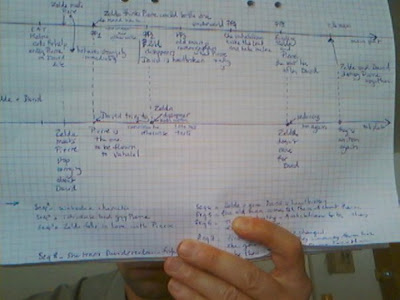I met Karl in central
Stockholm yesterday. We talked about the novel he’s writing. Karl is an American expat, living in
Sweden for the past 7 years. He’s writing wacky pieces about the life of a vinyl collector obsessed with the 70s rock scene.
The last time we met, he was just starting the very first pages.
3 years and 50 000 words later, Karl is sort of lost. He's right in the middle of his manuscript, but he’s not sure what he’s got so far and what to do with it next. Is the manuscript good? It looks like a mess right now. Does it make any sense? Surely there are pages that should go - others that should be added. And what about refining his ‘voice’ and making his novel funnier altogether.
Should he go back to page 1? Re-read it, and start rewriting it until the first 200 pages look like the proper first half of a novel?
What I told him is this: if he starts rewriting his novel before it’s finished, he will never complete it. He will spend the next 3 years rewording, rephrasing, randomly deleting and adding chapters until he will probably give up, like so many other writers before him.
This is an important trick: first you COMPLETE a first draft. You push your project, add words, scenes, chapters all the way to the final page - no matter how unreadable, awful or sketchy the writting. Only then, you can start rewriting and making it great.
A story is always written from the stand point of the last chapter. Frank Daniel used to compare it to the Greek mythology. When a hero dies and climbs up Mont Olympus, Zeus sees the man's life in reverse - from death to birth -, making sense of an entire existence through the stand point of the very last moments of the hero's life.
It’s exactly the same with a story. Until you’ve reached the very end, you can not know what fit or doesn’t fit anymore in your manuscript. Until your character has completed his journey and said his/her last word, you don’t know what pages should go and what chapter you must add.
So here the rule: if you ever want to complete your manuscript, once you’ve started it, you must always push forward. Don’t try to reword it, don’t try to correct it. Don’t read the opening chapters the hundredth time.
Always move on!
If you don’t find the exact word, or the sentence, or dialogue, just describe it roughly and mark it ***like so***
As in:
She threw the ball at him, “good catch,” she said and smiled.
“I thought so,” he smiled back ***an interesting action here to impress her***
Also, COMPLETING a manuscript, no matter how messy and sketchy, is going to give you a feeling of success and an energy that are going to be most needed for the rewrite.
So here’s the idea, Karl: finish the damned thing, add pages everyday until you reach a satisfactory and unavoidable conclusion to your story.
Then, we will talk about rewriting.
And with that said, we went for a beer at a cool place he knew near Medborgarplatsen and made more plans for more beers over the weekend.






